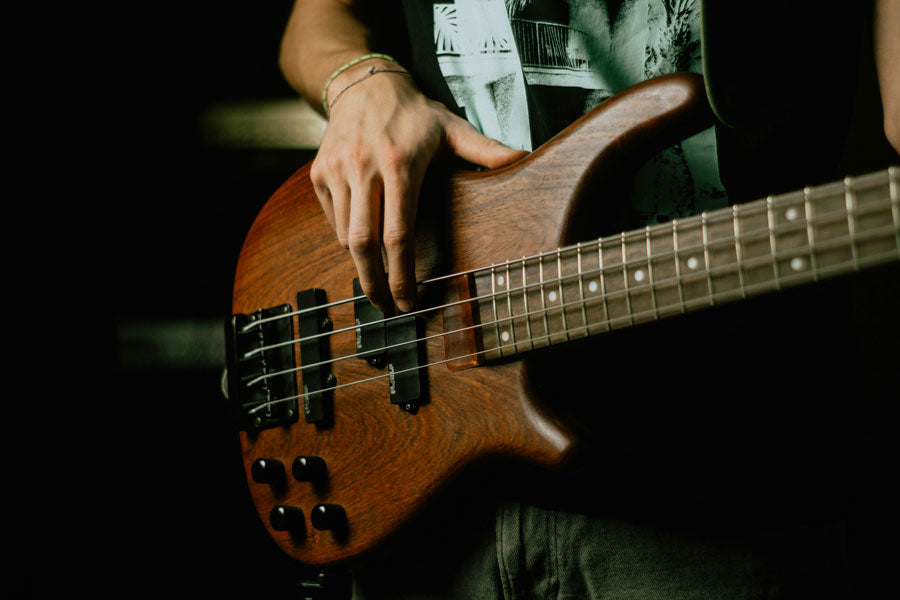
Can Guitar Pedals Be Used for Bass?
Share
Guitar effects pedals are useful tools for both electric guitar and bass. Bass players know they can achieve cool tones and effects from their instrument in unique and interesting ways.
Many bassists ask themselves, "Can I use guitar effects pedals with bass guitar?" The answer is a resounding yes! Adding guitar pedals to your bass guitar rig is becoming popular. They can expand your sonic palette while pushing traditional bass-playing boundaries.
Technical Considerations When Using Effects Pedals with Bass Guitars
There are several different technical aspects to consider, including output levels and frequency range that will have a significant impact on effects pedal’s performance. For example:
Output Levels
- Guitar Signals – the signals and pickups on electric guitars produce a moderate output level.
- Bass Signals – the signals and pickups on bass guitars are generally higher than electric guitars.
- As a result, feeding a bass signal into an effect pedal designed for guitar signals could produce unwanted distortion.
Frequency Ranges
- Guitar Signals – standard guitar tuning spans from low E (about 82 Hz) to high E” (about 659 Hz).
- Bass Signals – bass guitar signal standards range from low E (roughly 41 Hz) to high G (about 392 Hz).
Overall, the impact of effects pedals on bass guitars could lead to signal quality and dynamics issues if used incorrectly. Focusing on pedals with features that allow control of the input signal strength while maintaining dynamics and signal integrity at lower frequencies would be a better choice.
Common Pedal Types and Their Use in Bass
- Overdrive/Distortion – the key is to find effects pedals that can deliver powerful saturated tones while handling lower frequencies. Examples of overdrive pedals include JHS Pedals Moonshine V2 Overdrive, which delivers a clean blend, thick overdrive, and warm sounds. The EHX Big Muff Pi effects pedal can handle bass frequencies and offers distortion and thick fuzz while preserving the bass' natural character.
- Delay and Reverb – an example of a popular delay pedal is the TC Electronic Flashback 2 Delay. The Strymon BigSky is a high-end reverb pedal with numerous settings, including Shimmer, Hall, Room and many others.
- Modulation – this effects pedal can add new dimensions to bass guitar tones. Types of modulation pedals include chorus, phaser, flanged are, and tremolo pedals. Popular examples include the Boss CE-2W Chorus, the MXR Phase 90, the TC Electronic Vortex Flanger and the Strymon Flint Tremolo-Reverb pedal.
- Compression – the JHS 3 Series Compressor, Keeley Compressor Plus and Keeley Bassists are three of many examples of compressor pedals that deliver transparent, smooth compression.
Pros and Cons of Using Guitar Pedals for Bass
The pros include:
- Creative sound exploration
- Wide availability
- Versatility
- Increased sonic possibilities
The potential cons include:
- Potential impedance mismatch
- Frequency range limitations
- Adjustments needed to suit bass signals
Tips for Successful Integration
- Pick pedals with bass in mind – choose guitar pedals known to work with bass guitars. Find those with enhanced headroom, extended frequency response and features specific to bass playing.
- Less frequency-dependent pedals – choose pedals that focus on compression, reverb, delay and the like.
- Check for clean blends – find pedals with clean blend control. This makes it possible to mix dry and wet signals while preserving low-end signal quality.
- Adjust EQ settings – EQ settings are important because they preserve the bass' natural tone. Adjust the settings to maintain a balanced and clear bass tone properly.
- Experiment with signal chain order – change the order of the pedals in your signal chain to impact your tone. Place EQs and compressors early in the chain and reverb, chorus and delay pedals at the end.
Conclusion
Guitar effects pedals are great tools for expanding a bass guitar's sonic palette. We always encourage experimentation to improve the unique qualities of your bass guitar. Remember to choose pedals that are appropriate for achieving the results you’re after.
